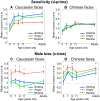Angry facial expressions bias gender categorization in children and adults: behavioral and computational evidence
- PMID: 25859238
- PMCID: PMC4374394
- DOI: 10.3389/fpsyg.2015.00346
Angry facial expressions bias gender categorization in children and adults: behavioral and computational evidence
Abstract
Angry faces are perceived as more masculine by adults. However, the developmental course and underlying mechanism (bottom-up stimulus driven or top-down belief driven) associated with the angry-male bias remain unclear. Here we report that anger biases face gender categorization toward "male" responding in children as young as 5-6 years. The bias is observed for both own- and other-race faces, and is remarkably unchanged across development (into adulthood) as revealed by signal detection analyses (Experiments 1-2). The developmental course of the angry-male bias, along with its extension to other-race faces, combine to suggest that it is not rooted in extensive experience, e.g., observing males engaging in aggressive acts during the school years. Based on several computational simulations of gender categorization (Experiment 3), we further conclude that (1) the angry-male bias results, at least partially, from a strategy of attending to facial features or their second-order relations when categorizing face gender, and (2) any single choice of computational representation (e.g., Principal Component Analysis) is insufficient to assess resemblances between face categories, as different representations of the very same faces suggest different bases for the angry-male bias. Our findings are thus consistent with stimulus-and stereotyped-belief driven accounts of the angry-male bias. Taken together, the evidence suggests considerable stability in the interaction between some facial dimensions in social categorization that is present prior to the onset of formal schooling.
Keywords: children; emotion; face; gender; representation; stereotype.
Figures




References
-
- Bates D., Maechler M., Bolker B. (2013). lme4: Linear Mixed-Effects Models using S4 Classes. R Packag. version 1.0.4.
-
- Birnbaum D. W., Nosanchuk T. A., Croll W. L. (1980). Children's stereotypes about sex differences in emotionality. Sex Roles 6, 435–443 10.1007/BF00287363 - DOI
Grants and funding
LinkOut - more resources
Full Text Sources
Other Literature Sources

